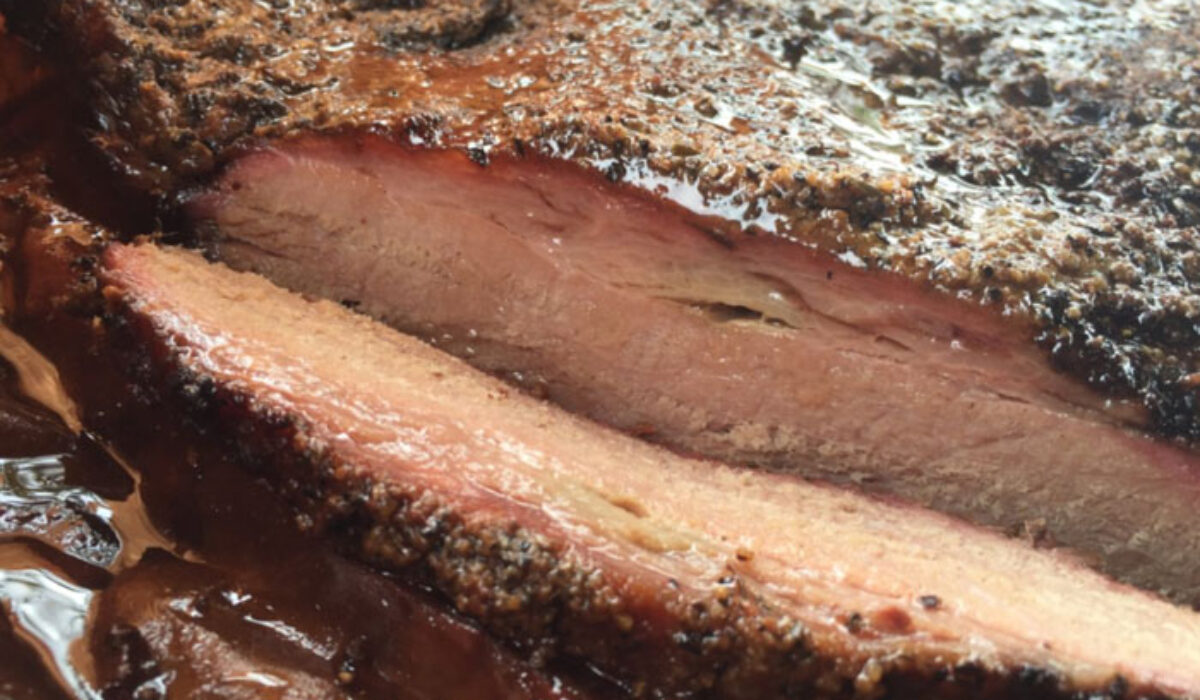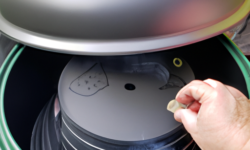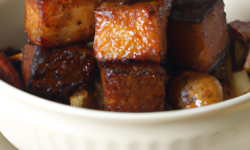This is just a simple list of tips that I’ve compiled for friends & family that have asked how to pull off a great Texas Style Brisket on the Big Green Egg. Take from this list what you like and make it your own – and leave a tip below if you have one to share!
To make Texas Style Brisket you need the following:
- A Whole Packer Brisket – Untrimmed – Choice or Prime (start with Choice)
- Post Oak Wood for Smoking
- Hardwood Lump
- Salt & Pepper (60/40 Pepper to Salt Mix) – Kosher Salt
- A drip tray (disposable or reusable – your choice)
- Pink Butcher Paper
- A remote temperature probe – I would recommend the “Smoke” thermometer from Thermoworks as it has 2 probes, one for the meat and one for the grid temp
- Beer (for as long as it takes to cook)
- Half sheet pan (to protect your counters)
- Brisket Knife for slicing – I use the Victorinox 12 Inch Fibrox Pro Slicing Knife with Granton Blade
Brisket Notes:
- On a large egg, the largest brisket I’ve been able to fit was a 22lber – untrimmed. It had to be “draped” over an inverted rib rack to clear the edges of the egg.
- I would recommend sticking with a 16-18lb brisket in order to make sure you have as much coverage with the plate setter as possible
- “Choice” grade brisket would be recommended for the first few attempts – then you can upgrade into “Prime”
- Up to 24 hours before your cook, trim the “hard” fat from the brisket – leaving about a ¼” cap all the way around – then season with the salt & pepper and let set for 12-24 hours until cook time
- Estimate 1-1.5 hours per lb (after trimming) for cook time – if your dome temp is 225-250F
- Target finished temp of the brisket 195-200F
- The brisket will “Stall” around 160-180 – meaning the temperature will stop climbing for some time. I’ve had briskets stall for up to 4 hours! Do not freak out – let it ride
- Once the brisket comes out of the “stall” (temp starts increasing at a faster rate) – wrap in the pink butcher paper and put back on the egg – letting it continue to cook through to 195-200F (or until it probes like butter – I have has some briskets that were perfect at 195 – others that have gone to 203)
- Probe placement in the brisket – I only probe the flat of the brisket – the point will cook just fine (and actually faster then the flat due to the fat content, so don’t worry about that side of the brisket)
Egg Setup/Starting Notes:
- Clean out your egg and stock with fresh lump the day before the cook, that way it’s ready to go when you are starting it at O dark thirty.
- Plan to start your egg 1 hours ahead of starting your cook – that way you’ve allowed plenty of time for the egg to stabilize and get a good smoke run.
- Fill egg with lump to the top of the firebox – light in the center of the lump, close the egg and let egg climb to 250F
- Once egg is at 250F, place your oak chunks on the lump in a circular pattern, with 1 piece in the center on the fire.
- Place your plate setter in the egg, legs up
- Add the drip tray with water on top of the plate setter – I use disposable aluminum trays that are about 3 inches deep – and I fill those all the way up (so plenty of water)
- Add your grid on top of the plate setter and close the egg.
- Let the egg get happy and stabilize between 225F-250F
The Brisket Cook:
- Put the brisket on the egg with the Fat side down. The fat cap will actually protect the brisket from the heat in the egg, preventing a “crispy” crunchy bottom.
- Probe placement in the brisket – I only probe the flat of the brisket – the point will cook just fine (and actually faster than the flat due to the fat content, so don’t worry about that side of the brisket)
- Shut the egg and let it ride – use the temp probes to watch the temperature without opening the egg.
- On some brisket cooks, I’ve started the egg at midnight, put the brisket on and then went back to bed – the egg will do it’s thing just fine.
- You may need to open it and fill the drip tray occasionally. If the drip tray drys out, it will start to burn and leave you with a bad taste on the bark
- Target finished temp of the brisket 195-200F
- The brisket will “Stall” around 160-18F – meaning the temperature will stop climbing for some time. I’ve had briskets stall for up to 4 hours!
- Once the brisket comes out of the “stall” – wrap in the pink butcher paper and put back on the egg – letting it continue to cook through to 195-200F (or until it probes like butter – I have had some briskets that were perfect at 195F)
After the Cook:
- Once you’ve hit the magical zone for the brisket, pull it off the egg and place on a sheet pan and let rest at room temperature (still wrapped in the paper) until the temp reaches 165F.
- This could take some time as the brisket will actually continue to cook and will go up to about 210-215F before the temp starts declining
- At this point, either place in an ice chest to hold warm or start to slice and serve
- If placing in an ice chest to hold, put a drip tray underneath the brisket because it will drip all over your ice chest.
That’s it! Seems like a lot at first – but as with anything, the devil is in the details and after a few brisket cooks, this will all be second nature
Tools Used:
- Thermoworks Smoke Thermometer – for remote monitoring
- Pink Butcher Paper – to wrap during the stall
- Victorinox 12 Inch Fibrox Pro Slicing Knife with Granton Blade
- Foodsaver Vacuum Sealer (for freezing leftovers)
- BGE Plate Setter (Conveggtor)
- Disposable Aluminum Trays (for drip pans)
ADVERTISEMENT



















I did one yesterday that was about ten pounds and a bit thin, although it plumped once it absorbed some heat. My on!y issue was keeping the temperature down. It kept rising into the 300’s even with the vents almost closed. I finally used some water to knock it down and that did the trick.
My guests were impressed and I was very pleased with the results .
I am curious, when you cook a 15-18 lb brisket according to your directions, what is the average total cook time?
Between 1-1.5 hours per lb. Usually closer to 1 hour per lb, but some butts can behave oddly
You can also wrap your oak chunks or whatever smoking wood you choose in foil so they don’t catch fire and raise your temp.
How long should I let my egg heat up, i keep getting that bitter taste in my meat,thanks
As long as it takes to get to a “thin blue smoke” – which will depend on your lump. If you are getting a severe bitter taste, change your lump to Fogo, Rockwood or BGE brand and give that a try.
Once you are ready for shutting the top and cooking the brisket how long can you leave it unattended before you need to check on it?
How many wood chunks do you add for this long of a cook?
3-4 depending on size
I’ve made three attempts with a 3.5 lb packer (nothing larger available unfortunately). Dome 225, grate varies but usually 235. I wrap in butcher paper at about 160. From there, I’ve had the stall last over four hours each time. I’ve even tried bumping up the temp by 10 – 15 degrees as I hit 172. Last time I had to resort to the Texas Crutch (foil) after a few hours and total cook time still ended up at 9 hours. What am I doing wrong?
3.5lbs? That’s the smallest brisket I’ve ever heard of. Is that just a point or the flat? What grade of meat are you using?
It’s a section that includes both point and flat. Unfortunately we don’t have many options during Quarantine. The ranch is too small for USDA grading, but I’d say it’s probably choice.
Question. Debating about filling the drip pan with liquid. If I cook at 250, and water boils at 215… Wouldn’t I just be steamingcooking the brisket?
The water will steam, yes, but you aren’t steam cooking the brisket. The steam helps create moisture and the water pan is more of a barrier from the heat source being directly under the brisket in the Egg (versus farther away in an offset)